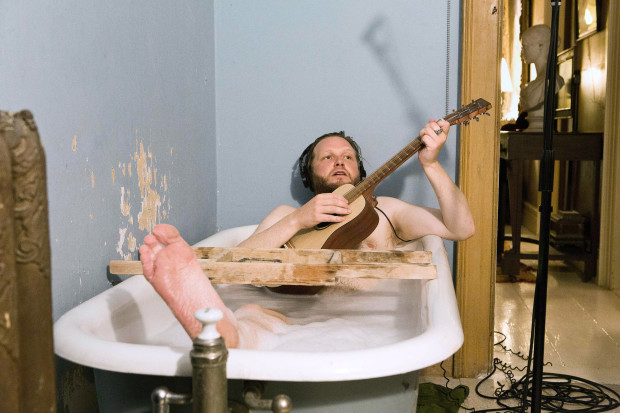You have no items in your cart. Want to get some nice things?
Go shopping
If you were to watch every exhibit in the Barbican’s Ragnar Kjartansson show for its duration, you would need a little over 24 hours. That’s not allowing for any time to wander among the paintings and is a flash in the pan in comparison to the number of hours that Ragnar and his co-performers spent creating the so-called “endurance art”.
These hours and days of investment are at the front of your mind as you move through the rooms of the Icelandic artist’s first UK solo exhibition. You can’t help but feel at the mercy of time and also that you are intruding on time that doesn’t quite belong to you. Take Me Here by the Dishwasher: Memorial for a Marriage 2011 – 2014, which opens the show, consists of a three-minute love scene from the first all-Icelandic feature film, Morðsaga (Murder Story), projected onto a white wall. Made in 1977 and starring both of Ragnar’s parents, it’s said that he was conceived during filming. 1970s chairs and sofas hug the edges of the space, each with an unrealistically neat collection of empty beer bottles arranged around it. In the middle is a mattress with a candy-pink silk cover on top and, on top of that, a topless troubadour lying on his back, eyes closed, playing his guitar. He is one of ten; the others sit and stand and drift in other corners as they pluck and sing their separate melodies, which come together in one polyphonic sound. They play the same few minutes on repeat for eight hours a day. The endless repetition might make meaning seem entirely absent, but something about being able to move through the space, about being at once a spectator and a participant, party to the events unfolding on screen, makes it almost unbearably intimate. You are being toyed with: one moment the troubadours are singing to you; you become a part of their fiction – or is it reality? The next they are lost in their own reveries of other times and places and you feel yourself a fiction.
The Visitors, 2012 uses the same technique of multiple voices singing in harmony but, whereas Take Me Here has something of the uncanny about it, this pitch black room with nine screens all showing a different musician performing in a different room of the same big old house feels … inevitable. Here you’ll find Ragnar as he appears on the exhibition posters: in a bath with his guitar; dirty, cold-looking water slopping up the sides as he plays and sings: “There are stars – exploding – around you, and there’s nothing – you can do.” It’s as if there’s nothing he can do in that moment other than repeat those words over and over, focusing completely on conveying the truth of them. The expression on his face is one of physical effort; he is willing the meaning over to you. All the while and as with the first piece, repetition threatens to wash away meaning. That meaning almost reaches you, but the dust motes on which they ride fall to the ground or get blown off course just before they can.
In all this repetition and is-there-isn’t-there-a-higher-purpose? questioning lies a profoundly Beckettian sense of humour. There is something completely ridiculous about God, 2007. After fighting your way through a lustrous pink curtain, Narnia-style, you find yourself in an entirely pink room watching a screen on which one man (Ragnar) stands in front of the same lustrous pink curtain, wearing black tie. He is accompanied by a sizeable band also all wearing black tie and croons over and over again (for 30 minutes, should you care to stay for the whole thing): “Sorrow conquers happiness.” Yes, you find yourself nodding, how right he is. Then: What? No. What does that even mean? You work out what it means but it seems impossible, all the more so because Ragnar himself is violently happy as he performs.
Then there’s Me and My Mother, an ongoing piece of work which began in 2000. Ragnar stands next to his actress mother (who also appears in Take Me Here, you’ll remember) in the same spot in their home every five years, while she spits on him for varying amounts of time (7 minutes, 3 minutes 40, 20 minutes and 20 minutes 25 respectively) and with varying vigour. At first you laugh, but this is arguably the most moving piece in the whole show: over the four videos you see the trust between them grow. He may have a beard and she may have grey hair by the 2015 video, but he looks at her as if he were a small child who knows nothing of the world and is asking her to guide him, knowing she will acquiesce.
Mostly, though, Ragnar is in complete control of his work. For The End – Venezia, 2009, he and a model/performance artist friend spend 144 days (six months) holed up in the ground floor of a fourteenth-century palazzo on Venice’s Grand Canal. Björnsson wears only a pair of Speedos and Ragnar paints a new portrait of him every day of their self-imposed incarceration. Sometimes we see only the model’s reflection; at others, he is there surrounded by portraits from previous days in a sort of Alice in Wonderland mad-house, so that you’re not sure which is the “real” Björnsson. Often the pictures are completely without perspective and this strange man in his Speedos floats in seas of red or lime green or murky brown. He is a madman in a pulpit, a T. S. Eliot scholar, a sufferer of anxiety. The cumulative effect of this fictional rendering of a lived experience is magnificent: the pent-upness the two men underwent, the simultaneous claustrophobia and excitement, is transposed onto the viewer, who also wonders: “Is this the real life?”.
This interaction between pieces is the most wonderful thing about the show. Visual references, related lyrics (two of the pieces involving song feature the word “sorrow”), recurring characters and places. Towards the end of the exhibition you find the source of the bangs which made you jump at the very beginning, and while seeing the cause of the bangs that first ludicrous and lovely refrain, “Take me here by the dishwasher”, is carried on the air to the upper level. You begin to feel haunted. Is that good or bad? It’s hard to tell.
Many of the works ask not so much “what are we doing?” but “why are we doing?” For all that, these are not expressions of desperation or existential turmoil. Ragnar cites Marina Abramovic as one of his main influences, but in his work we find something warmer than what his forbear offers: an intimacy that extends to the viewer, and not just to one viewer at a time, but to a whole gallery-full at once. Here is playfulness, endless entertainment, a child questioning with an adult’s intellect. Here is integrity to a philosophy of time. It makes for a gallery experience unlike any other.
Ragnar Kjartansson continues at the Barbican Gallery until September 4. Tickets £12 (£10 concessions/Art Fund, £8 students, £5 Young Barbican).

About Rosanna Boscawen
Rosanna Boscawen's short stories have been published by Liar's League and .Cent magazine, and she has written for The New York Observer, Prospect magazine and The Observer New Review. She grew up in Suffolk and now lives in London.




